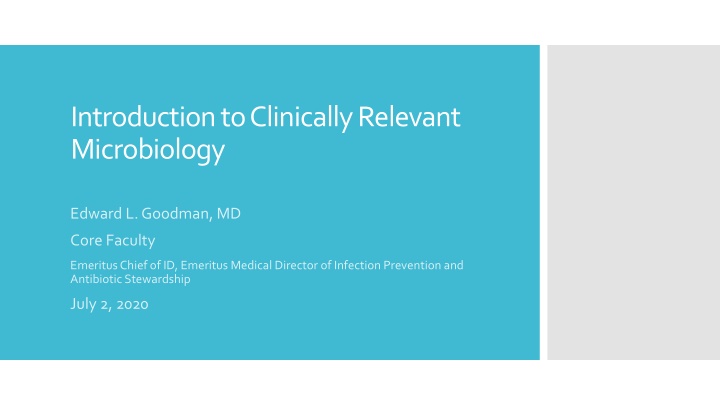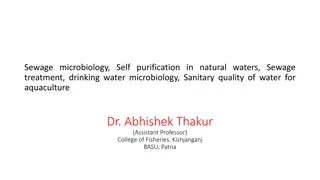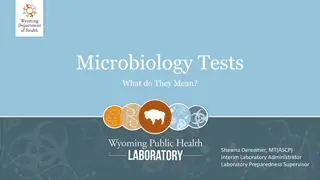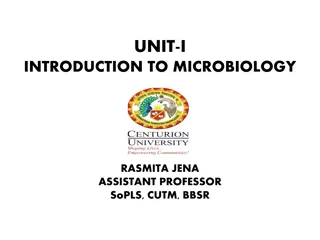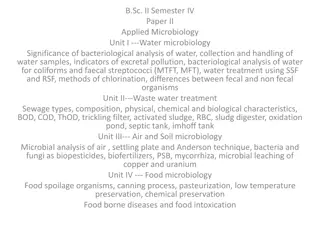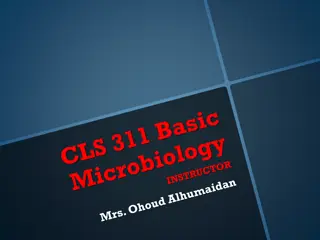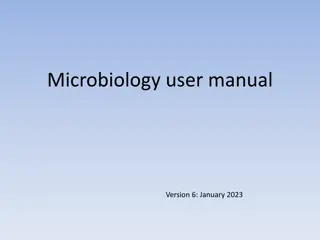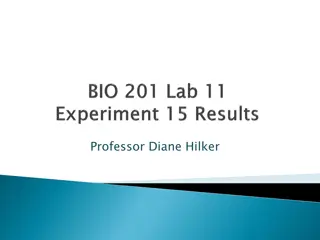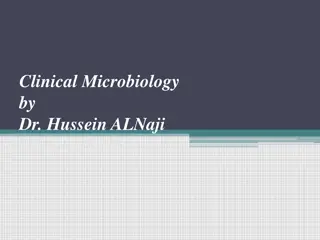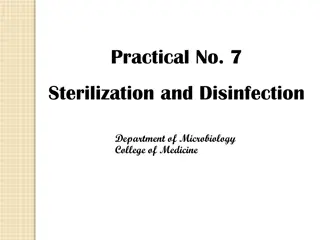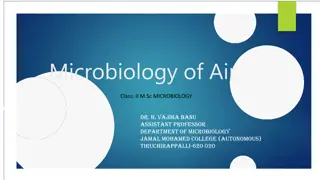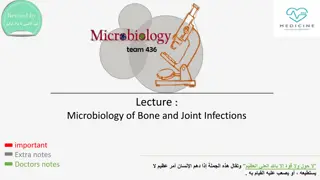Clinical Microbiology Overview & Management Insights
Explore clinically relevant microbiology with a focus on major bacteria groups encountered in practice. Gain insights on Staphylococcus aureus, beta-hemolytic streptococci, and Enterococcus management strategies. Understand resistance mechanisms and antibiotic susceptibility testing.
Download Presentation

Please find below an Image/Link to download the presentation.
The content on the website is provided AS IS for your information and personal use only. It may not be sold, licensed, or shared on other websites without obtaining consent from the author.If you encounter any issues during the download, it is possible that the publisher has removed the file from their server.
You are allowed to download the files provided on this website for personal or commercial use, subject to the condition that they are used lawfully. All files are the property of their respective owners.
The content on the website is provided AS IS for your information and personal use only. It may not be sold, licensed, or shared on other websites without obtaining consent from the author.
E N D
Presentation Transcript
Introduction to Clinically Relevant Microbiology Edward L. Goodman, MD Core Faculty Emeritus Chief of ID, Emeritus Medical Director of Infection Prevention and Antibiotic Stewardship July 2,2020
Major Groups of Bacteria Encountered An Overview of What the Micro Lab Does Newer Technology A Few Pearls Outline A Primer on Susceptibility Testing Review of some resistance mechanisms Summary of Everything You Wanted to Know about Antibiotics
Staphylococcus aureus (includes OSSA and MRSA) Hints about detecting On gram stain: GPC in clusters Coagulase positive = Staph aureus Grow rapidly in blood cultures (<12 hours) 99% beta lactamase producing = penicillin resistant MRSA 52% When considering S aureus as a pathogen, must cover MRSA until ruled out Gram Positive Pathogens: staphylococci Staphylococcus epidermidis and other coagnegative staph Usually heteroresistant = methicillin resistant But if lab shows oxacillin sensitive, believe it (and stop vanc!)
Beta hemolytic Always penicillin and cephalosporin sensitive After 70+ years, still no resistance to penicillin G Aggressive just like S aureus Necrotizing Group A Strept/Toxic Shock require anti-toxin therapy as well Clindamycin or linezolid are drugs that affect protein synthesis; toxins are proteins Streptococci Viridans Almost always sensitive to Ceftriaxone. Penicillin sensitivity variable
Inhibited but not killed by beta lactam monotherapy For endocarditis, require bactericidal therapy Penicillin or ampicillin plus aminoglycoside Alternative penicillin or ampicillin plus ceftriaxone For non endocarditis, does not require cidaltherapy, so no need for combined therapy VRE uncommon (8% of E faecium) Choices include ampicillin for E faecalis, linezolid, daptomycin Still requires contact precautions during and after active infection since GI colonization cannot be eradicated Enterococcus
Enterobacteriaceae: E coli, Klebsiella, Proteus, Serratia, Shigella, Salmonella, Citrobacter Grow aerobically and anaerobically Can grow in anaerobic as well as aerobic blood culture bottle Increasing mechanisms of resistance (more later) Non fermenters: Pseudomonas, Acinetobacter Inherently drug resistant and increasing acquired resistance Only grow in aerobic blood culture bottle Opportunistic pathogens Often require combination empiric therapy until susceptibility proven No evidence that double coverage protects against emergence of resistance Aerobic Gram Negative Rods
Gram negative: Bacteroides, fusobacteria Normal distal gut and vaginal flora Usually beta lactamase producing Usually part of mixed flora Distinct gram stain appearance and putrid odor Proteus also have a distinct odor (H2S) Anaerobes: think of when dealing with infections coming from or adjacent to mucosal surfaces Gram positive: peptococci/streptand clostridia Normal oral pharyngeal flora Not beta lactamase producing = penicillin Rx effective More aero-tolerant and less susceptible to metronidazole
Bacteriology Blood Urine Respiratory Stool Wounds Sterile body fluids Tissue What Does the Micro Lab Do? Serology Molecular (formerly viral)
Typical = M. tuberculosis AFB smear from sputum = place patient in Airborne Precautions Send three smears at 8 hour intervals, with one in early AM If all three negative, Infection Prevention may allow Airborne Precautions to cease Always check with IP before stopping Airborne Direct PCR on sputum available for M. Tb as well as INH, Rif resistance (Cepheid) Geneprobe on culture allows distinction between M. Tb and Avium, Kansasii Mycobacteria
Slow growers M. avium Mimics TB Disseminated in HIV M. kansasii Mimics TB M. marinum Aquarium, extremities, grows at lower temperature Atypical Mycobacteria Rapid growers = resistant to standard TB drugs M. fortuitum M. chelonei M. abscessus
Yeasts Candida Cryptococcus Sporotrichosis Hyphae formers Dimorphic = geographic distribution Histo, Cocci, Blasto Opportunistic Aspergillis Zygomycetes Fusarium Mycology
Protozoans (do not cause eosinophilia) Malaria = rapid antigen test, thick and thin smears Amoeba = rapid antigen test, serology Giardia = rapid antigen test Leishmania = histopathology Worms = detected by microscopy (eggs and segments) Roundworms (Ascaris, Strongyloides, Necator, pinworms) Flukes (Schistosomiasis, Fasciola) Tapeworms (Taenia) Parasitology
No longer culture technology, only PCR and serology Biofire Respiratory panel 16 viruses, 3 bacteria Several corona viruses detected but not yet COVID (soon we hope) Stool panel = restricted to ID and GI CSF panel = restricted to ID EBV CMV HSV JK Community acquired enterovirus panel not in use yet Virology
Susceptibility tests often lead directly to treatment No other lab has that influence Imagine a report that says: K is 3.0. Treat with 40 meq KCL! Hgb 6.7. Treat with 2 u packed RBC But a urine culture growing 100,000 CFU of E coli susceptible to levofloxacin almost always leads to an order!! Just like Dr. Strangelove s mechanical arm. Unique Features of Microbiology Lab
Automated blood culture detection = 24/7 positive results called to patient s nurse Rapid susceptibility testing For most common organisms, MIC is resulted in 18 hours after growth on solid media Molecular detection of resistance genes is available 4 hours from detection in liquid media look for it in EMR or call On gram positive, can detect S. aureus, Coag neg staph and Mec A (=MRSA.) Report that states Staph species does not mean necessarily coag neg. It still could be S. aureus. Gram negative = many enterobacteriaceae species, someESBL targets. Not detecting an ESBL does not rule ESBL out. Have to wait on MICs Technology in Micro Nucleic acid amplification: N. gonorrhea, C. trachomatis on voided urine, as well as penile or cervical discharge DNA probe for Mycobacteria tuberculosis Fluorescent In Situ Hybridization (FISH): examples MALDI-TOF = Mass spectrometry time of flight: examples
Swabs only for throat; cervical and urethral swabs require special GC media For abscesses, NEVER SEND SWAB. Instead promptly send liquid pus in capped syringe Gram stain showing GNR but no aerobic growth, think of anaerobes Anaerobic cultures only from abscesses, blood, tissue Never from sputum, stool, urine, genital, CSF (OR YOU WILL BE LAUGHTED AT!) Why? These sites have a normal anaerobic flora Some Pearls Blood culture for GPC positive within <12 hours = likely S. aureus Growth in anaerobic bottle could be enterobacteraciae (E coli, etc) or anaerobes, although anaerobes grow slower than aerobes Growth in aerobic bottle could be enterobacteraciae or non fermenters (Pseudomonas, Acinetobacter)
Nucleic Acid Amplification Tests (NAAT) for gonorrhea and chlamydia are for: Men: voided urine, pharynx, anus Women: voided urine, pharynx, endocervix, anus Do not allow susceptibilities, only detection of DNA Neisseria gonorrhea is very fastidious, requiring X and V factors present in chocolate agar. Cultures are discouraged, but: For sterile body fluid (joints, CSF) chocolate agar can grow N. gonorrhea and everything else For mucosal sites (pharynx, cervix, rectum, urethra), chocolate agar grows EVERYTHING so must use Selective Inhibitory Agar (Jembec plates-Thayer Martin with Vanc, Colistin, Nystatin) with CO2 tablet. Then sealed in a bag Call Micro Lab (X6350) for the appropriate media Whenever a culture for gonorrhea is sent, IT MUST BE IMMEDIATELY TAKEN TO LAB or isolates will die More Pearls
For aerobic/facultative bacteria only For anaerobes, fungi, mycobacteria, it is a send out Cascade reporting is a requirement for Antibiotic Stewardship Reporting broad spectrum drugs only when there is resistance to narrow spectrum drugs Susceptibility Testing Suppressing drugs If inappropriate for the site e.g., nitrofurantoin for E coli in blood If not in the formulary So, if you are using a drug that is not in the susceptibility panel, there is a reason no need to call Micro to test it or release result.
Patient Lab Test = test tube Has excretory organs None Drug levels are not constant Constant Sequestered foci where drugs penetrate poorly Uniform distribution of drug How Does a Patient Differ from a Test Tube? Proteinbinding of drugs: only unbound is active No protein, only liquid media Antimicrobial PMN s,globulins, complement None
Cephalothin(obsolete precursor to cefazolin) was active against Strept pneumo But didn t work in CSF. Why? No active drug penetration into CSF, only an inactive metabolite. Therefore, Susceptibilities Can be Misleading Ampicillin inactive against all Klebsiella Yet it can work in simple UTI. Why, concentration in urine well above MIC The original form of imipenemcould treat E coli bacteremia but not UTI Why, it was inactivated in kidney due to an enzyme (dihydropeptidase) Addition of cilastatin inactivated enzyme that inactivated imipenem!
Disc diffusion give zone sizes Kirby Bauer Do not allow comparison between drugs Still in use for selected isolates for which MIC can t be done: Types of Susceptibility Testing Dilution determine Minimum Inhibitory Concentration (MIC) Tube dilution Microtube dilution Agar plate dilution Hybrid test = E test
Relationship between MIC and Zone Size
Nothing unless you understand pharmacokinetics of the drug Achievable serum level Look in Care Connect References either Sanford or Lexicomp Penetration into various body compartments e.g., urine, CSF, bile The same MIC can be considered susceptible or resistant depending on the site of infection (see example on next slide) What Does a MIC Mean?
Mechanisms of Antimicrobial Activity FC TenoverAmerJ Med 2006;119: S3-10
DNA-directed RNA polymerase DNA gyrase Quinolones Cell wall synthesis Rifampin -lactams & Glycopeptides (Vancomycin) DNA THFA mRNA Trimethoprim Protein synthesis inhibition Ribosomes Folic acid synthesis DHFA 50 30 50 30 50 30 Macrolides & Lincomycins Sulfonamides PABA Protein synthesis inhibition Tetracyclines Protein synthesis mistranslation Aminoglycosides Cohen. Science 1992; 257:1064
Mechanisms of Antibiotic Resistance PM Hawkey, The origins and molecular basis of antibiotic resistance. Brit Med J 1998;317: 657-660
Amp C Cephalosporinases Chromosomal cephalosporinase SPICE organisms (Serratia, Pseudomonas, Indole positive proteae, Citrobacter, Enterobacter) Inducible enzymes may be provoked by exposure to certain beta lactams Not clinically important unless combined beta lactam therapy used When combined cefoperazone-piperacillin used for febrile neutropenic patients at UCLA, resistant Pseudomonas emerged (Winston D, AJM 1980 s)
Constituent Production Amp C - Continued A tiny minority of strains are overproducers of Amp C cephalosporinase Not detected by standard lab MICs When the majority (susceptible) strains are eliminated, the mutant overproducers survive and thrive Not inhibited by beta lactamase inhibitors Classic Darwinian Selection survival of the fittest. Those not producing Amp C are killed leaving behind Amp C producers Now, plasmid mediated non-inducible Amp C cephalosporinase are recognized Can transduce resistance to other species by conjugation No longer limited to SPICE organisms
Another Beta Lactamase: Extended Spectrum Beta Lactamases (ESBL) Plasmid mediated Linked with other resistance genes Derived from broad spectrum older beta lactamases known for years such as TEM, SHV, OSA Substrates (meaning drugs that enzyme destroys) include all penicillins, 1st-3rd generation cephalosporins but not cephamycins (cefoxitin/cefotetan) and carbapenems Inhibited by beta lactamase inhibitors, but PARADOX 2 Pip/tazo and others may not be clinically effective Probably because of other plasmid mediated resistance mechanisms such as Amp C plus porin changes Treatment of choice was CARBAPENEMS Now, ceftolazone/tazo and ceftaz/avi have some activity
The Last Line of Defense Fortunately, our most potent -lactam class, carbapenems, remained effective against almost all Enterobacteriaceae. Doripenem, Ertapenem, Imipenem, Meropenem Unfortunately, Antimicrobial resistance follows antimicrobial use as surely as night follows day
Carbapenemases in the U.S. Enzyme Bacteria KPC Enterobacteriaceae Metallo- - lactamase P. aeruginosa OXA Acinetobacter spp. SME Serratia marcesens
A Primer on Beta Lactamases and Newer BLIs Van Duin, Bonomo. Clin Inf Dis 2016; 63 (2):234-241
New Delhi Metalloproteinases (NDM-1): As if we didn t have enough to worry about!
Resistance Summary Resistance to most antibiotics is inevitable Mitigate the damage by Enforcing Infection Prevention measures Hand Hygiene Contact Isolation when appropriate Gowns and gloves for patients with MDR organisms Antibiotic Stewardship Less broad spectrum Shorter duration Continued research into new mechanisms of antibiotics Incentives to PHARM for new drug development Extension of patent protection
